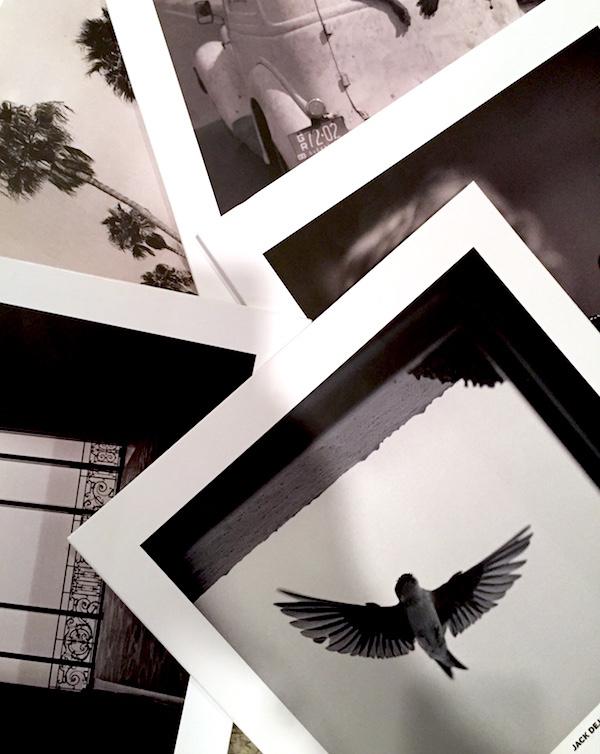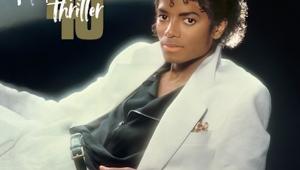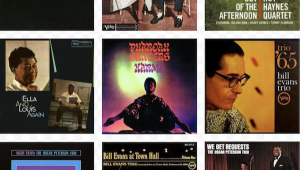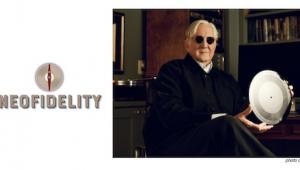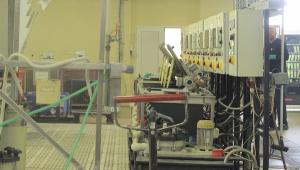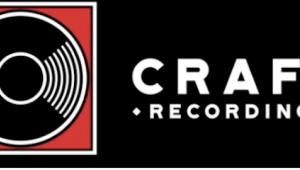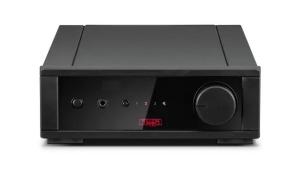Newvelle Records Completes First Year and Funds Second
The label is the result of collaboration (after a piano lesson in 2014) between an artist—jazz pianist and composer Elan Mehler— and a businessman—Jean-Christophe Morrisseau. Despite the retro-technology of the musical delivery system, funding for the endeavor is modern crowdsourcing—the second year of which is still underway.
2016’s six releases, five of which have already been delivered are:
Frank Kimbrough Quintet Meantime CNV001LP)
Jack DeJohnette Return (NV002LP)
Noah Preminger featuring Ben Monder, John Patitiucci and Billy Hart Some Other Time (NV003LP)
Don Friedman Strength and Sanity (NV004LP)
Ben Allison Trio Ted Nash and Steve Cardenas Quiet Revolution (NV005LP)
And soon to be released: Leo Genovese featuring Esperanza Spalding and Jack DeJohnette , the title of which has yet to be revealed (at least not on the company’s website.
The Physical Product
All of the recordings are produced at EastSide Sound in New York City and are engineered by Resident Chief House Engineer Marc Urselli, who claims five Grammy® nominations and three wins. However, these were not for his engineering work. Rather they were for the artists (Best Pop Instrumental: Laurie Anderson), etc.
Urselli’s lengthy client list runs from Laurie Anderson to John Zorn. According to his website, four of these Newville records were recorded in a single week!
For the Newvelle records Urselli says he uses “mostly vintage and some tube microphones…and some tube preamps.” All is kept in the analog domain, run through a Harrison Series Ten B analog board. Reverb is mostly analog spring, with occasional Lexicon 480.
The recording medium, however, is Pro Tools HDX, not analog tape, at at least 24 bit 88.2kHz resolution. The fully automated mixing board is analog, which means there’s a D/A conversion for mixing and then back to digital for the final files, which are then sent to Masterdisk for lacquer cutting, which for the first series were cut either by Alex deTurk or Scott Hull.
Either lacquers or plated lacquers (perhaps done in N.J. at Mastercraft?) are then quick-shipped to MPO in France for pressing on translucent white 180g vinyl. The early releases packaged the records in thick paper sleeves, each of which features a poem by Pulitizer Prize winning poet Tracy K. Smith. Later ones feature the same sleeve with poem but package the records better, in a second, rice paper lined sleeve.
The records come in highly stylized, identical gatefold jackets of a fine, satiny-feel opaque paper. Each jacket and inner gatefold features well-reproduced monochrome and color photographs from the archives of the renowned and well-traveled French photographer Bernard Plossu.
The minimalist jacket approach eschews annotation and credits are in small type on the jacket back, below which it says “Liner notes and more information:newvelle-records.com”. Unfortunately I could not find on the website either liner notes or more information, which I found disappointing.
When you go to the website you’ll find hyperlinks attached to some of the musicians’ names that take you to their websites, but not all of them are listed so if you’re unfamiliar with the names, your search is on.
More importantly, there’s a back story to be told about each of these records that would add meaning and value but for now it’s a lost opportunity. I understood this omission early on when I first connected up with Newvelle but less so now.
After reading this review, Mr. Mehler informed me that there are liner notes for each record but to access them one must be a subscriber, which I am not, though I did get the records for review.—ed.
Music and Sound
With New York based Mehler acting as A&R man for the label, not surprisingly most of the musicians are New York based and many have performed and recorded with each other.
Because I’m not going to review each of the records separately, let me generalize: the music is more “in the pocket” than it is exploratory, which makes complete sense given the label’s mission. The first release by pianist Frank Kimbraugh and his group begins with a smart cover of the familiar Brecht/Weill “Alabama Song” and also includes a lovely “boppy” cover of Andrew Hill’s “Laverne” that you can listen to here. The set ends with an elegant cover of the standard “Last Night When We Were Young” and in between are Kimbraugh’s tuneful originals.
The recording quality is “studio high”. That is, there less of an attempt to produce the sound of a combo playing “live” in a room (even though they were) and more of one to get solid sonics from each by using isolation and then producing a pleasing musical as opposed to spatial mix.
On the Kimbraugh opening tune, the drums are not splayed across the soundstage, which is good, and the same is true of Kimbraugh’s piano. In fact, the mix is kept tidily between the speakers on a relatively narrow stage that’s almost monophonic.
But by the second track the mix spreads the drums across the stage, which I find distracting, though the overall mix is otherwise deft. The tonal balance is decidedly warm, which works especially well on the piano and sax but the cymbals are soft and lacking in shimmer and “ring”. The intimacy of the miking and mix limits air around some of the instruments but that’s more than made up for by the naturalness of instrumental attack and a total freedom from grain and “etchiness”. If you like rich, you got it!
The Jack DeJohnette solo piano record is a dreamy, late night pleasure that’s closely miked in stereo and so is from the player’s perspective. Again it’s a warm sounding record that’s not about presenting a piano in a space that you can “see”. Rather it’s a large, richly drawn one that lets you see the pianist’s hands as he moves across the keyboard, while the tonal perspective accentuates the overtones rather than the instrument’s harder, percussive qualities. DeJohnette’s compositions are highly impressionistic as if he’s accompanying the action to a film you cannot see. The key to getting the most from this record is correctly setting the volume. Also, MPO does a better job than many other pressing plants in keeping the spindle hole centered, which prevents “wow”.
Newvelle 0003LP is a group led by Noah Preminger a young sax player who produces the most adventurous and challenging yet breathtaking music so far in this series, backed by veterans: guitarist Ben Monder, bassist John Patitucci and of course drummer Billy Hart. The final track on side one, “Una Limosna por el Amor de Dios” written by the obscure Paraguayan guitar virtuoso who died in 1944, is a “disc stopper” almost paralyzing in its beauty.
Preminger’s adventurous song selection includes “Try a Little Tenderness”, Bob Dylan’s “Boots of Spanish Leather” and Red Hot Chili Peppers’ “Porcelain”.
Like the others so far, this is slow, ruminative set dripping with atmosphere. A nice touch is Monder’s guitar bathed in dreamy reverb. This is by far the best-recorded album in the set in my opinion, because the warmth is sufficiently tempered to allow Preminger’s reed to not be buried and for his instrument to stand out on the soundstage. Pattiucci’s bass is equally well-served, with natural attack, sustain and decay. I’m still not a fan of widely panned drums however, but that’s just me.
I believe Strength and Sanity was veteran pianist Don Friedman’s final album. He passed away less than a year after recording this album September of 2015, which consists of eight compositions written by the late jazz trumpeter and composer Booker Little, Jr. who died in 1961 at age 23 of kidney failure. Friedman was gigging around New York as late as May of 2016 a few weeks before he passed away.
Friedman, who some readers may be familiar with from his Riverside albums, especially A Day in the City and Circle Waltz, was 81 when he recorded this record and his playing is that of a much younger man, backed by bassist Phil Palombi and drummer Shinnosuke Takahashi about whom I know nothing because the hyperlink to his website on the Newvelle website was broken.
If you dig ‘60s era aggressive, muscular, “toe tapping” jazz with walking bass lines and abrupt changes, you’ll dig this record and of course Friedman’s playing, which may remind you because of its occasional breeziness, of Bill Evans’ but only superficially. Friedman is more aggressive and less introspective.
Of course Friedman’s death is tragic, considering the high level of his playing here, but we’re lucky to have this record. The piano recording is superb too and placed solidly stage-left, with Palombi’s bass equally well-recorded.
However here, the drum panning is really annoying and distracting especially because the drums are well- recorded but placed too high in the mix as opposed to back in the mix where they’re placed on a few of the other albums. Instead of providing an accent, Takahashi’s cymbal hits sometimes sound like a drummer looking to draw attention from the pianist instead of supporting him (not the drummer's fault). Still, this is a great record of straight ahead jazz from a now gone veteran and it’s my favorite along with the Preminger record.
Finally, there’s the latest in the set, bassist Ben Allison’s Quiet Revolution (005) featuring saxophonist Ted Nash (not his late uncle the saxophonist with whom he shares a name) and the spare, elegant guitarist Steve Cardenas who here eschews effects and is brilliantly captured by the recording engineer. Sonically this is the cleanest most satisfying record, in part because there’s no drummer and so no splashy panning but also because the imaging is so palpable and the instruments so well-layered. This is also the most sonically transparent recording and the least eager to ooze “warmth”.
Most of the songs are by the great guitarist Jim Hall with originals, one each by Allison and Nash and a pair by Jimmy Guiffre along with the closer “Love Theme From Spartacus”. The ensemble playing on Hall’s “Waltz New” is a highlight. More records that sound like this one please!
You can order a box set of the first season’s records and/or sign up for the second now on the label’s Kickstarter page. The project will be funded this Wednesday November 30th. The pledges have exceeded the goal but don’t let that stop you.
The first season’s releases are very high quality musically, sonically and physically. The pressing quality is very good too, though a few records had a bit of noise on the first track, which is usually a “non-fill” issue, though it’s minor.
This is a series of uniquely produced, well-recorded, musically adventurous jazz albums by some of today’s most highly regarded composers and players. An accomplished, steady and true beginning for a fledgling record company, I’d say.
